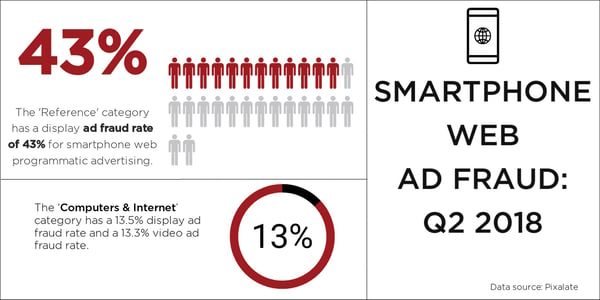
This week's review of ad fraud and quality in the digital advertising space.
Pixalate has released the Q2 2018 rankings for the Global Seller Trust (GSTI), Mobile Seller Trust (MSTI), and Video Seller Trust (VSTI) programmatic Seller Trust Indexes. Pixalate's Seller Trust Indexes rank the overall quality of programmatic sellers across desktop and mobile web, mobile in-app, and video advertising.
Download the Q2 2018 rankings here.
2. The 'Reference' category has a 43% ad fraud (IVT) rate on smartphones

Pixalate examines invalid traffic ("IVT") rates across popular mobile web publisher categories. The ‘Reference’ category (e.g. dictionaries, thesauruses, directories) has a display ad fraud rate of 43% for smartphone web programmatic advertising — highest among the 15 domain categories Pixalate tracked for this study.

"Index Exchange is to press pause on a controversial real-time bidding (RTB) tactic known as 'bid caching' after an impassioned debate kicked off last week," reported Adweek. "The tactic involves holding onto the details of a DSP’s unsuccessful bid request for an individual ad impression auctioned-off using RTB. It then uses the details of that same request to serve an ad on behalf of the DSP on a later piece of content viewed by the same consumer," explained Adweek.

"According to a new WARC global ad trends report, advertisers are expected to spend $29.8 billion on online video this year, an increase of 27.5 percent, with most of that going to social media platforms," wrote Adweek. This expected rise comes despite the fact that "the medium is also a prime target for ad fraud," noted Adweek.
According to Pixalate's Q2 2018 Programmatic Quality report, tablet app video and smartphone app video have the two highest ad fraud (IVT) rates across all devices and channels.

"Although many experts do expect connected TV advertising to eventually catch up to consumer adoption, several obstacles stand in the way," wrote eMarketer in a piece exploring the rise of Connected TV and where marketers currently stand in the environment. "By 2022, more than 204 million people in the US will watch connected TV at least once a month. That will represent more than 60% of the population, and will add around 183 million more viewers to the US connected TV audience in 2018."
Sign up for our blog to stay updated with new stats, trends, and analysis of digital ad fraud.
*By entering your email address and clicking Subscribe, you are agreeing to our Terms of Use and Privacy Policy.
These Stories on Weekly Recaps
*By entering your email address and clicking Subscribe, you are agreeing to our Terms of Use and Privacy Policy.

Disclaimer: The content of this page reflects Pixalate’s opinions with respect to the factors that Pixalate believes can be useful to the digital media industry. Any proprietary data shared is grounded in Pixalate’s proprietary technology and analytics, which Pixalate is continuously evaluating and updating. Any references to outside sources should not be construed as endorsements. Pixalate’s opinions are just that - opinion, not facts or guarantees.
Per the MRC, “'Fraud' is not intended to represent fraud as defined in various laws, statutes and ordinances or as conventionally used in U.S. Court or other legal proceedings, but rather a custom definition strictly for advertising measurement purposes. Also per the MRC, “‘Invalid Traffic’ is defined generally as traffic that does not meet certain ad serving quality or completeness criteria, or otherwise does not represent legitimate ad traffic that should be included in measurement counts. Among the reasons why ad traffic may be deemed invalid is it is a result of non-human traffic (spiders, bots, etc.), or activity designed to produce fraudulent traffic.”

